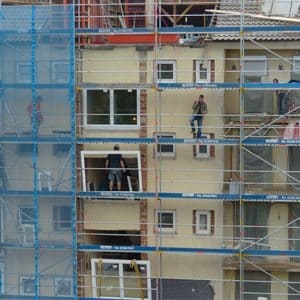In recent months, New Yorkers have heard a lot about something called the "Scaffold Law." Advocates for the law's "reform" call it antiquated, an economic non-starter. Supporters, people who want to keep the law the way it is, say it affords necessary protections to construction workers, men and women who put their lives on the line day in and day out to keep New York City strong.
So what is the Scaffold Law anyway? And who's right: is it friend or foe?

The Scaffold Law, NYS Labor Law sections 240 / 241, is just a small part of New York State's Labor Laws, a vast body of legal regulations that dictate the proper and improper ways to treat employees and maintain workplace safety.
In essence, the Scaffold Law forces "absolute liability" on contractors and property owners for any "elevation-related" injuries that occur on New York City construction sites.
If you're working up high, using a ladder or scaffolding, and fall, it doesn't matter whether or not you made a mistake. Your actions don't come into the equation. Instead, your employer is thoroughly responsible for the accident.
The answer to that question is complicated, because it depends on who you ask.
The anti-Scaffold Law camp points out that the law forces New York's contractors to purchase an additional, general liability policy, in addition to workers comp policies. These extra policies increase the average cost of every building project that starts in the city. Some estimates put the cost increase, per project, in the millions. As a result, contractors are forced to choose between hiring more workers or saving money on insurance. New York City loses jobs, and families are left without a source of income.
Public projects aren't immune to the law either. Government agencies have to buy insurance just like everyone else. But this time, taxpayers are hurt. Buying additional insurance to protect against "elevation-related" accidents forces politicians to raise taxes if they want public developments to work.
According to Congress' Joint Economic Committee, New York's unemployment rate is still well above the national average. Some believe that retaining the Scaffold Law as-is would only stifle job growth in the state.
Beyond economic arguments, the anti-Scaffold Law lobby says it's just not fair. Not every construction accident is a contractor's fault, so why should they be penalized for the mistakes of their employees?
For a quick overview of the argument for reform, check out this article.
Those who want to keep the law argue that reforming, or repealing, the Scaffold Law would give contractors and developers more power than they already have, which is a lot. Construction is extremely dangerous work, especially when workers have to hang from ladders and scaffolds to do it. Losing the Scaffold Law would eliminate one of the primary incentives that property owners and contractors have to maintain safety on the job site. In short, when employers are scared of a lawsuit, they'll work harder to protect workers.
The Occupational Safety & Health Administration (OSHA) can't do the job of safety alone. In fact, it's unclear whether or not they can do it at all. The average fine for a regulation violation is only $13,000, a drop in the bucket for most big construction companies. The Scaffold Law keeps contractors honest in a way that the federal government just can't.
And while unemployment is still high, New York is making significant gains. Net job gains, the number of jobs created minus those lost, represent a 3% increase in the state's employment since the recession. Only six other states can claim as much and, while it's not earth-shattering news, there's no evidence that the Scaffold Law has impeded the state's ability to create work. Plus, job growth is outstripping population growth, which has stagnated at 0.3% since 2007, by 900%. Jobs are coming back to New York, and the Scaffold Law hasn't changed anything.
According to Richard T. Anderson, President of the New York Building Congress, "thanks to an improving economy, increased foreign investment, and continued progress on a handful of major public and private sector initiatives, the New York City construction market has just about fully rebounded from its post-recession depths and is nearing boom territory once again."
Visit this article at the New York Daily News for another pro-Scaffold Law perspective.
Reformers want to replace the Scaffold Law's rule of "absolute liability" with one of "comparative negligence." Comparative negligence is already a big part of New York's personal injury law, but what does it mean?
If both a plaintiff and defendant are found negligent, the jury must determine each party's percentage of fault and award damages based on that percentage. It's that simple.
What do you think? Should the Scaffold Law be changed or stay the same? Let us know in the Comments section below and if you have any questions, one of our construction accident lawyers will respond.